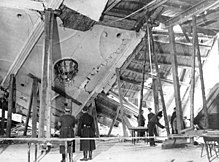Bürgerbräukeller
This article needs additional citations for verification. (July 2010) |


The Bürgerbräukeller was a large beer hall located in Munich, Germany. It was one of the large beer halls of the Bürgerliches Brauhaus company, and after Bürgerliches merged with Löwenbräu, the hall was transferred to that company. It was located on Rosenheimer Street in the neighborhood of Haidhausen, behind today's Gasteig Culture Center. Today, the Hilton Munich City Hotel and the headquarter of GEMA are located on the property.[1]
Nazi connection
From 1920 to 1923, the beer hall was one of the main gathering places of the Nazi Party. It was there, on 8 November 1923, that Adolf Hitler launched the Beer Hall Putsch.
After Hitler seized power in 1933, he commemorated each anniversary of the failed rebellion by giving a speech in the Bürgerbräukeller to the surviving veterans of the Putsch.
In 1939, an anti-Nazi workman, Georg Elser, concealed a time bomb in the Bürgerbräukeller, set to go off during Hitler's speech on 8 November. The bomb exploded, killing seven people and injuring sixty-three, but Hitler escaped unharmed; he had cut his speech short and left about half an hour early. Elser was arrested, imprisoned for 5 ½ years and executed shortly before the end of the war.
The building suffered severe structural damage from Elser's bomb and was never rebuilt. In subsequent years, Hitler held his annual Pustch commemoration gatherings at the Löwenbräukeller at Stiglmaierplatz instead.[2]
Until the end of war in 1945, the Bürgerbräukeller was used for food storage. During the Allied occupation of Germany the building was converted into a USO. It was reopened as a beer hall and event location in 1958. The building was demolished in 1979 in favor of new construction, as were the nearby Münchner-Kindl-Keller and the Hofbräu brewery. Today, a memorial plaque dedicated to Elser is located at the site.
References
- ^ "Historisches Lexikon Bayerns - Bürgerbräukeller, München". georg-elser.de. Retrieved 2010-04-11.
- ^ Hauner, Milan (1983, 2005, 2008), [http://books.wa7di.com/data/Hitler_A_Chronology.pdf
http://www.scribd.com/doc/24365561/Adolf-Hitler-a-Chronology-of-His-Life-and-Time HITLER - A Chronology of his Life and Time], Houndmills, Basingstoke, Hampshire and New York: Palgrave Macmillan, pp. 158 (year 1940), 171 (year 1941), 183 (year 1942), 190 (year 1943), ISBN 978-1-4039-9492-9
{{citation}}: Check|url=value (help); Check date values in:|date=(help); line feed character in|url=at position 52 (help)
